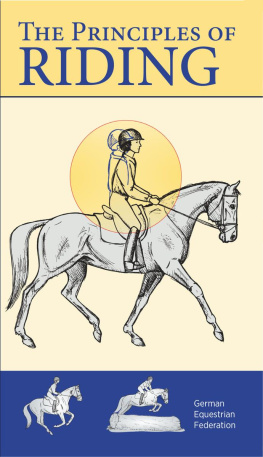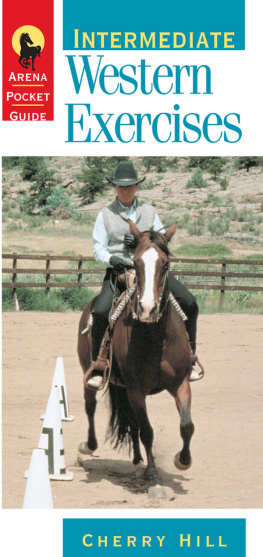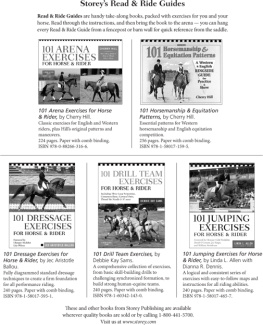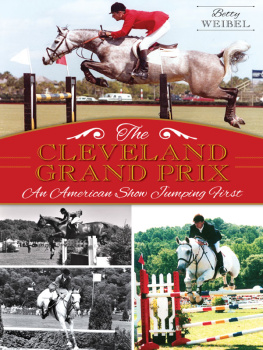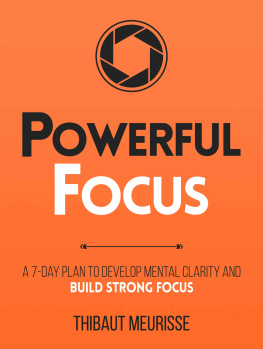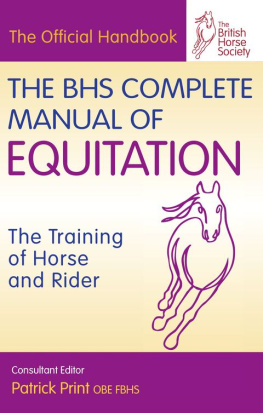101 JUMPING EXERCISES
FOR HORSE & RIDER

Linda Allen on Mystic.
101 JUMPING EXERCISES
FOR HORSE & RIDER
LINDA L. ALLEN
WITH DIANNA R. DENNIS
Foreword by Olympic Gold Medalists
David OConnor, Joe Fargis, and William Steinkraus
ILLUSTRATIONS BY SUSAN E. HARRIS

The mission of Storey Publishing is to serve our customers by
publishing practical information that encourages
personal independence in harmony with the environment.
Edited by Deborah Burns
Cover design by Rob Johnson, Johnson Design
Art direction by Meredith Maker
Text design by Susan Bernier
Text production by Kelley Nesbit
Copy-edited by Sue Ducharme
Front cover photograph HorseSource/Peter Llewellyn
Back cover photograph courtesy of Linda Allen
Interior photographs: courtesy of Linda Allen, ii, v, xii, 8, 98, 146, 227; Cathrine Cammett, 209; Tony DeCosta, vi, 66; HorseSource/Peter Llewellyn, 112, 166, 196; Charles Mann, xi, 14; Tish Quirk, x, 13,122, 208; by Ed Lacey, courtesy of William Steinkraus, viii; courtesy of James Wofford, 210
Illustrations by Susan E. Harris
Arena diagrams by Chuck Galey
Indexed by Susan Olason/Indexes & Knowledge Maps
Special thanks to Rodrigo Pessoa, pictured on the cover, for permission to use this and other photographs, and to Missy Clark, Anthony DAmbrosio, Joe Fargis, Hap Hansen, David OConnor, William Steinkraus, and James Wofford for their contributions to this book.
2002 by Linda L. Allen and Dianna Robin Dennis
All rights reserved. No part of this book may be reproduced without written permission from the publisher, except by a reviewer, who may quote brief passages or reproduce illustrations in a review with appropriate credits; nor may any part of this book be reproduced, stored in a retrieval system, or transmitted in any form or by any means electronic, mechanical, photocopying, recording, or other without written permission from the publisher.
The information in this book is true and complete to the best of our knowledge. All recommendations are made without guarantee on the part of the author or Storey Publishing. The author and publisher disclaim any liability in connection with the use of this information. For additional information please contact Storey Publishing, 210 MASS MoCA Way, North Adams, MA 01247.
Storey books are available for special premium and promotional uses and for customized editions. For further information, please call 1-800-793-9396.
Printed in the United States by Versa Press
10 9 8
Library of Congress Cataloging-in-Publication Data
Allen, Linda, 1946
101 jumping exercises for horse and rider / Linda Allen
with Dianna R. Dennis.
p. cm.
ISBN-13: 978-1-58017-465-7; ISBN-10: 1-58017-465-5 (alk. paper)
1. Jumping (Horsemanship) 2. Show jumping. I. Dennis, Dianna R. II.
Title.
SF309.7.A58 2002
798.2'5dc21
2002010550
Dedicated to our HORSES, whose patience and unique brand of intelligence never cease to amaze us

And to the memory of Bert de Nemethy, a true master of classical horsemanship

Grand Prix Show Jumper Peter Leone.
CONTENTS
Sections
Basic Exercises from the Walk and Trot
(Exercises 125)
Turning Poles into Jumps: Gymnastics
(Exercises 2640)
Gymnastics with Varying Strides
(Exercises 4149)
Using Gymnastics for Both Turns and Straightness
(Exercises 5053)
Canter Exercises: Poles
(Exercises 5464)
Canter Exercises: Jumps
(Exercises 6573)
Encountering Challenges
(Exercises 7495)
Exercises for the Most Advanced Horses and Riders
(Exercises 96101)
Appendix
Guest Contributors

William Steinkraus on Snowbound, winning the 1968 Olympic Gold Medal.
FOREWORD
Getting to Carnegie Hall
by William Steinkraus, 1968 Individual Olympic Gold Medal, Show Jumping
So how do you get to Carnegie Hall? Weve all heard the punch line: practice. Its a provocative idea with an element of truth, but as we all also know, success is really not quite that simple. Another piece of the success puzzle would be, Where are you starting from? Youd also need to ask, What should I practice and how often, and for how long?
In a general way, the basic answers to such questions are the same whether you aspire to play in Carnegie Hall or ride in the Olympic Games. What you have to practice, in order to fulfill your true potential, is everything you will need to master, from the most basic, simplest skills to the most difficult and complex. Even more important is the quality of practice: you have to practice correctly, not just go through the motions. But surely, the sounder your technical foundation and the more approaches to achieving your goal that youve mastered, the better youll be able to accomplish any particular component when the time comes.
This book deals with the kinds of exercises you will need to master before you can think realistically about meeting the challenge of jumping obstacles, whatever their degree of difficulty or the complexity of their arrangement. When I was a kid in the 1930s, most of the courses we jumped werent very complicated, and even the best horsemen didnt spend much time inventing fancy schooling exercises. We didnt have to. Today, however, its a very different matter, for even Equitation courses can be very complicated and pose lots of technical questions. Any rider who hasnt worked out most of these problems in schooling wouldnt stand a chance.
I myself had never realized how much you could accomplish with cavalletti and gymnastic exercises until I came under the influence of Bertalan de Nemethy, the late, great trainer of the United States Equestrian Team (USET), and this may well have been Lindas experience, too. For surely one of the cornerstones of Berts success and that of his team was the fact that horses and riders who had graduated from his comprehensive course of cavalletti and gymnastics rarely encountered on course a problem that they did not know how to solve and had not practiced solving over and over again, and in a variety of different ways. Bert surely knew a lot of different ways to get to Carnegie Hall, and as his pupils demonstrated, he knew how to build the technical foundation one requires to meet Show Jumping challenges, even at the Olympic level.
Linda Allen is a horsewoman of vast experience who has, since her retirement as a top-notch competitor, observed the best riders in the world on a very regular basis. As a world-class course designer, she has been the one to decide which questions to ask of Show Jumpings elite on many occasions. The schooling exercises she and her guest experts have set forth on the following pages are a marvelous and generous contribution to the sport of Show Jumping, for they can provide the foundation for solving even the knottiest problems todays best course designers typically pose.
Next page


